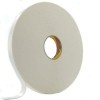What temperature can double-sided adhesive tape withstand? Technical qualities
What temperature can double-sided adhesive tape withstand? In some cases, it makes no sense to wonder what the ideal operating temperatures are for double-sided tape.
For example, in applications of double-sided tape happening inside an apartment, i.e., in an environment where, in principle, temperatures will always remain between 17 and 28 °C (62.6 – 82.4 °C), so what is normally referred to as room temperature.
In this case it won’t be necessary to look for a double-sided adhesive tape with any particular properties related to operating temperature. What about extreme uses, however? Think, for example, about using of a double-sided adhesive tape in an outdoor environment, with temperatures that can go down to 10 °C (50 °F).
Or, at the opposite end of the spectrum, using double-sided adhesive tape in industrial environments, where temperatures can reach 40, 60 °C (104, 140 °F) or even more. In this case, before using a strong double-sided adhesive tape to replace other structural binders such as screws, nails, welds, or rivets, it is good practice to check what temperature the double-sided adhesive tape can withstand, then choose the most suitable one to meet your needs.
In our e-commerce site, in the category dedicated to high performance double-sided tapes, you’ll be able to pinpoint products designed specifically to withstand even particularly high or particularly low temperatures.
The relationship between adhesives and temperature
Before checking what temperature the double-sided adhesive tape is able to withstand, it may be useful to offer a brief theoretical introduction to the relationship between adhesives and temperature.
In fact, it must be stated from the outset that temperature affects adhesives at the application and durability levels, as well as, even earlier, the storage level.
A similar argument can also be made about another very important environmental factor, such as humidity.
In any case, it should be noted that small variations in temperature, even in the range of 5 degrees, can have significant consequences on the long term in relation to the durability glue: in most cases, as the exposure of the adhesive applied to conditions beyond its ideal operating temperature of use increases, there will be a significant reduction in its resistance.
The reason is simple: the operating temperature an adhesive will affect in a concrete way the structure of the bonding agent itself. The polymerization time also varies.
In the case of anaerobic sealants, for example, the general rule states that, for each increase in temperature by about 8 °C, polymerization time is halved; on the contrary, for each reduction in temperature by 8 °C, polymerization time is doubled.
Generally speaking, when talking about the lasting power of an adhesive and, therefore, its resistance once it is applied, what is being discussed are measurements and estimates made on a “room” temperature of about 20 °C (68 °F), which in most cases is the ideal operating temperature.
What temperature can industrial double-sided tape withstand?
Given the above, it is not surprising that in the world of adhesive production and, of course, double-sided adhesive tape as well, the search for solutions to make these tools more resistant to particularly low or particularly high temperatures is constant.
It is therefore up to the user of the double-sided tape to identify what will be the operating temperature and, based on that data, to orient their choice towards the most suitable product, with a greater or lesser environmental adaptability. It should be said, however, that it isn’t only temperature that should be taken into account, but application time as well.
Think for example of an industrial double-sided tape with a marked environmental adaptability: this can be used in the short term even in environments with temperatures above 200 °C (392 °F) but should only be used in environments with temperatures below 130 °C (266 °F) in case of long-term attachment.
These, it must be said, are particularly high results. Very often, when talking about strong double-sided adhesive tape resistant to high temperatures, what is referred to are tools which can offer long-term stability in a temperature range between -40 °C (-22 °F) and 90 °C (194 °F), with the ability to offer short-term adhesion even if exposed to temperatures of 120 °C (248 °F).
Obviously, it might be useful for users to understand what the “short or long terms” indicated by producers correspond to.
Unfortunately, exact answers cannot be given: the resistance time range of any particular adhesive tape resistant to high temperatures can be very heavily influenced by the load to which it is subjected, by the surfaces on which it is placed, the moisture content, the type of storage prior to use, the pressure applied at the time of attachment, the vibrations present in the environment, and so on.
In principle, however, the adhesion duration in the short term refers to hours to days, whereas the long term refers to weeks to months: this just to offer have a reference order.







